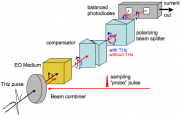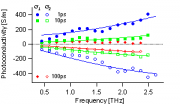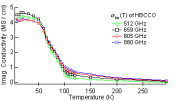Uploads by Pcunni1
Jump to navigation
Jump to search
This special page shows all uploaded files.
| Date | Name | Thumbnail | Size | Description | Versions |
|---|---|---|---|---|---|
| 18:30, 23 September 2009 | THz exp setup.png (file) |  |
41 KB | Schematic diagram of a typical THz time-domain spectroscopy experimental setup where THz pulses are generated via "optical rectification" and detected via free-space electro-optic sampling. | 1 |
| 08:47, 24 September 2009 | FSEOS of THz.png (file) |  |
43 KB | In free-space electro-optic sampling, the THz waveform and a ultra-short "probe" pulse propagate collinearly through an electro-optic medium. The THz field induces birefringence in the EO medium through the Pockel effect, rotating the polarization of the | 1 |
| 09:08, 24 September 2009 | THz PDA.png (file) |  |
49 KB | Schematic diagrams of THz generation from transient photocurrent in a photoconductive dipole antenna, and detection by an THz field-induced transient photocurrent in a photoconductive switch. | 1 |
| 09:14, 24 September 2009 | THz OR.png (file) |  |
21 KB | THz "optical rectification" occurs by nearly-degenerate difference frequency mixing between the frequency components of an ultra-short pulse in a 2nd order nonlinear optical medium. This process is capable of producing very broadband THz pulses. | 1 |
| 18:48, 24 September 2009 | THz Polymer vs ZnTe.png (file) |  |
3 KB | The THz bandwidth available using polymer detector far exceeds that available using the inorganic crystal ZnTe, due to improved phase matching in the polymer. | 1 |
| 09:41, 4 October 2009 | Polymer dynamics.png (file) |  |
3 KB | The THz conductivity dynamics observed in an amorphous polymer film at various delays after photo-excitation shows an evolution from dispersive transport to a bound excitonic response. | 1 |
| 10:55, 6 November 2009 | HBCCO Tdep.png (file) |  |
4 KB | THz TDS is used to map the temperature dependence of the conductivity in the high-temperature superconductor HBCCO, showing an sharp increase in the imaginary component near the critical temperature where Cooper pairing becomes efficient. | 1 |